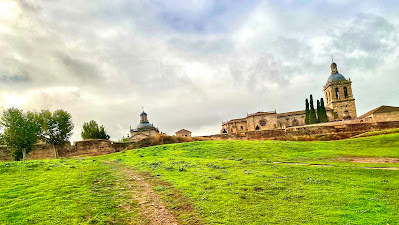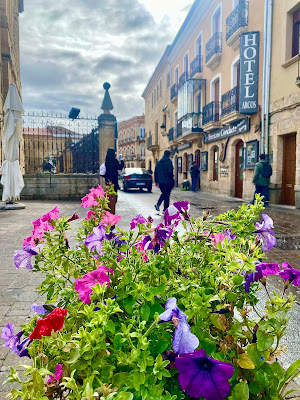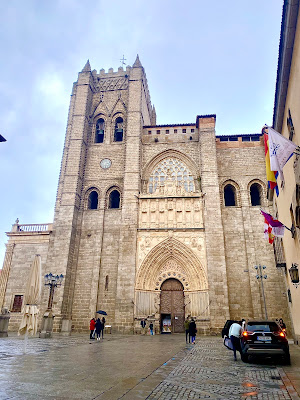Traveling broadens your horizon. It enriches your mind and your spirit. But traveling uses up a lot of your time and treasure. It would be a waste if you missed something on your trip you should’ve seen or experienced. It happened to me several times and I regretted that so much. If you’re planning a trip, I’d like to help you avoid missing out. So, let my blog show you what to look out for. Prepare for your trip by traveling with me through this post. Or you might still be in the praying and dreaming stage. Manifesting your dream into reality starts here!
A
Happy Solo in the Royal Palace of Madrid
What’s the closest you
ever got to feeling like royalty?
Me? I stepped into a
grandiose palace and felt a bit like Cinderella in rubber shoes.
Opulent. Magnificent.
Regal. That’s what El Palacio Real Madrid (The Royal Palace of
Madrid) is to a T. It’s the largest functioning royal palace in Western Europe
with 3,418 rooms, double the size of Buckingham and Versailles.
It wasn’t a pilgrimage
destination but since we were already in Madrid, we might as well see how the
Spanish royals lived.
Once upon a time, it
was a Moorish castle. Then a royal residence. Today it’s still used for state
ceremonies even if the royal family no longer live there. So don’t expect to
rub elbows with the king and queen when it’s your turn to visit. But feel free
to imagine yourself dressed in your best fairy-godmother-conjured gown (or a
bemedalled princely garb for the men) dining and dancing in their noble
company. And of course, as modern day princess or prince wannabes, you’ll want
to document your “Day in the Royal Palace” with photos in the plush salóns
of this imperial edifice. I’ve listed the rooms and things that would be nice
to include in your album. By the way, tripods or selfie sticks are not
permitted.
Another helpful-to-know
when you don’t have a tour guide with you: there’s an audio guide available
that will tell you about each room that you’ll go through.
So, let’s sashay through
the palace and feel like a royal for day.
Before entering, take
the best full view of the palace in the Plaza de Armería (Armoury
Square),
the square between the
south façade of the Royal Palace and the Almudena Cathedral.
The parade grounds is
where the Change of Guards ceremony takes place.
Have your picture taken
while regally ascending the Escalera Principal (Grand Staircase).
The staircase was made from a single piece of San Agustin marble.
Gaze up at the ceiling
of the Salón de Alabarderos (Halberdier’s Hall – named after the elite
guards of the royal family). There’s a beautiful fresco of Venus ordering
Vulcan to give weapons to Aeneas and aid in the conquest of Rome.
Get
bedazzled by the glitter of the crystal chandeliers and ornate tapestry of the Salón de
Columnas (Hall of Columns) a room that was used as a banquet
hall in times past.
In the Antechamber
of Charles III (the beginning of the king’s apartment area), see if you can
spot Hercules receiving immortality from the gods in the ceiling fresco by Anton
Raphael Mengs.
Salón
de Gasparini (Gasparini Room) or the Chamber of Charles III was
done in elaborate Rococo style. Take note that the plants motif of the floor
continues to the walls and even adorns the upholstery. With that dedication to
detail, it’s no surprise why it took 55 years to complete this room.
Test how good your eyesight
is by locating the camouflaged door in this room which served as a small private
chapel for the king. The door was for the servants to slip from room to room unnoticed
and arrive ahead of the royals they wait on.
If you’re fascinated by
all things porcelain, this one’s for you – the Gabinete de Porcelana
(Porcelain Room). Wall to ceiling porcelain panels are “masterfully assembled that
the joints are concealed by vine tendril motifs”. That alone makes your photo
here Instagram-worthy.
Now picture yourself as
one of the 130 honored guests partaking of a sumptuous dinner on this 40-meter
long table in the Comedor de Gala (Banquet Hall).
Do you love desserts
like I do? Here’s a room that tickled my sweet tooth just by imagining it
overflowing with delectable confections – the Dessert Room. What piqued
my interest was silversmith Luigi Valadier’s deser or dining table
centerpiece from 1778. The deser was made from a combination of hard and
soft polychromatic stone with gilded silver, bronze, and gold decoration, made
richer by jasper, ivory, agate, and lapis lazuli inlay. Just wow!
Imagine lounging on
this ottoman eating grapes and sipping champagne. The operative word is
“imagine” as you won’t be allowed to sit there. So just snap your photo beside
this one in the Silver Exhibition Room where you can also view some
antique gifts and possessions of the Royal Family.
At the Capilla
Real (Royal Chapel), I reverted back to pilgrim mode by saying a thank
you prayer to God for blessing me with the chance to view this magnificent
palace. Before taking photos and being stunned by the frescoes, golden arches
and sculpted stucco art, why not offer up your prayers first too.
Do you like music? Then
don’t miss the photo op in the Queen’s Salon and the Stradivarius
Room. Antique musical instruments are on exhibit here including the
Stradivarius Palatine Quartet which is unique in the world. These were made in
the 17th century and are still used in concerts held in the Hall of
Columns.
Let your breath be taken away by the regal splendor of the Salón del Trono (Throne Room) with its plush red velvet canopy and walls, intricately gilded moldings and spectacular frescoes by Giambattista Tiepolo, called the greatest decorative painter of 18th century Europe.
Lastly, don’t miss taking the most regal mirror selfie you can ever have. There’s a huge antique mirror reflecting a room with paintings and imperial ornaments complete with a chandelier as you exit from the Throne Room to the Grand Staircase. Pose there and thank me later. 😊







































